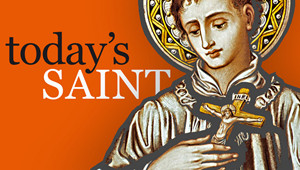Three years ago the U.S. Religious Landscape Survey by the Pew Research Center's Forum on Religion & Public Life has stated that one out of every 10 Americans is an ex-Catholic. If they were a separate denomination, they would be the third-largest denomination in the United States, after Catholics and Baptists. One of three people who were raised Catholic no longer identifies as Catholic.
 The Pew report shows that half of those who left the Catholic Church have joined other churches. Of these "71% said that they left the Church because their spiritual needs were not being met." Richard Gaillardetz, professor of theology at Toledo University, explained this as happening "because the quality of Church life is poor and church leadership is inattentive to their real pastoral concerns." By "quality" he seems to refer to teaching, preaching or community life and liturgy.
The Pew report shows that half of those who left the Catholic Church have joined other churches. Of these "71% said that they left the Church because their spiritual needs were not being met." Richard Gaillardetz, professor of theology at Toledo University, explained this as happening "because the quality of Church life is poor and church leadership is inattentive to their real pastoral concerns." By "quality" he seems to refer to teaching, preaching or community life and liturgy.
Fr. Thomas J. Reese, S.J. at the same time commented "Any other institution that lost one-third of its members would want to know why. But the U.S. bishops have never devoted any time at their national meetings to discussing the exodus. Nor have they spent a dime trying to find out why it is happening."
Thinking about this, I find it interesting that all three of the Liturgical Readings for this week focus specifically on the notion of priestly service and ministry.
We see the Apostles asking the community to select some of its own members for the ministry of service, so that they could concentrate on prayer and the ministry of the word. (Acts 6:4) This fits a pattern for the early church: the priests would serve the community by being persons dedicated to prayer, teaching and presiding at Eucharist. Members of the laity, both men and women would take ownership of the other aspects of their community life.
According to scripture scholars, the First Letter of Peter was written between 70-90 A.D. to the Christian communities located in five provinces in Asia Minor, and addresses the difficulty of living the Christian life in a hostile, secular environment that upholds different values and subjected the Christian community to ridicule and oppression. The author reminds the people: "let yourselves be built into a spiritual house, to be a holy priesthood to offer spiritual sacrifices acceptable to God through Jesus Christ," And he assures them: "you are 'a chosen race, a royal priesthood, a holy nation, a people of his own, so that you may announce the praises' of him who called you out of darkness into his wonderful light."
The Second Vatican Council gave us the opportunity to rediscover the original model of church. More and more lay men and women have responded to the challenge of the Gospel to use their gifts and charisms for the service of the community of believers. More and more, the laity understands that they are the Church. Ordained clergy, priests and deacons, along with religious men and women, do have special roles within the community, but they are servants, and they are not the Church. We have come to understand that our faith rests not in the organization that we call "church" but in the Person who gathers this community - this church - together. This is a theme that Pope Francis seems to return to - over and over.
Today's Gospel is a scene from the Last Supper, occurring on the first Holy Thursday, which is seen as the traditional celebration of the institution of the Priesthood. Scripture tells us that Jesus did three things that night which define the sacramental nature of the priesthood: He commissioned his disciples to bring His healing power of forgiveness, allowing us to reconcile ourselves with one another and with God; He gave them a clear example of what being a "servant" truly means by washing the feet of his friends; and He commissioned them to gather the people around His table, break bread with and for them, and make present among them - once again - His Body and Blood.
The first disciples gradually came to understand their special role as "priests," and from what we find in scripture and tradition they had no problem sharing the other aspects of that priesthood with others.
Somewhere throughout the years of history, these original notions of self-understanding were lost in an organizational structure that separated the people of God into two classes: clergy and laity. Somewhere along the way, the priesthood of Jesus Christ became seen as a special gift offered only to a few, rather than the duty and responsibility of all baptized Christians.
This becomes painfully evident when we realize that the crisis of dwindling numbers is not specific to America alone. Catholics are leaving the church in staggering numbers throughout the world as well. The crisis within the Church today is not one of priesthood. The sacramental priesthood is alive and well, and there are thousands of good priests struggling daily to bring the Good News to God's people. And there are just as many laypersons who understand well their own roles in the priesthood of Jesus.
The scandal lays in the "understanding" of what priesthood means and the mindset of a clerical state that views this priesthood as a privileged way of life, a protected zone where canon law is absolute.
St. Thomas Aquinas taught that the Church should be seen as having three interconnected and collaborative components. One is the hierarchy, the magisterium, the teaching and governing authority of the church. Another is the scholars and theologians, who carefully examine our past and look outward with discerning eyes at what the horizon seems to promise. And the third is the lived experience of the people of God, possessors of the sensus fidelium.
When the hierarchy is not written off as irrelevant, when theologians are not silenced, and when the members are not denied their legitimate collaboration, the church is functioning at its best and we can be certain that the work of the Spirit is being optimally facilitated. But when these three are out of sync, when there are distrust and contention among them, when one group assumes that they alone are the voice of authority, the church becomes dysfunctional, is crippled and its problems will never be resolved.
We can achieve more by working together rather than in isolation or in competition with each other. There is no dobut that there has been a general decline in church involvement, prestige and influence, a decline in vocations to the priesthood and religious life, a growing alienation of the laity, and a sense that the church is not relevant in today's society. We need to challenge and reverse this development.
In our Gospel today, Philip speaks one famous line that is recorded for all time: "Lord, show us the Father, and that will be enough for us." These words sum up the entire purpose and direction of the human journey. They enunciate the basic longing of our hearts to see God, to know Him, to love Him and to serve Him. They reflect the longing of those whose spiritual needs are met in the church and those whose needs are not.
Philip speaks for all of us when he says to Jesus: "We really only need one thing - to see God; show us how to do that, and that will be enough!"
Jesus answered with words that are equally critical for us: "Have I been with you for so long a time and you still do not know me?"





